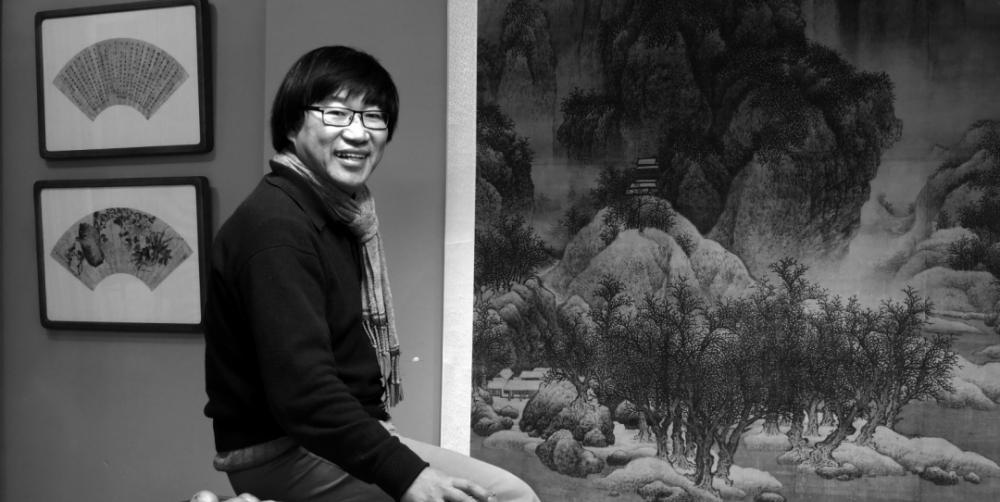Artist Profile
Artist profile

Wang Zuojun
Born in 1960 in Beijing
Associate Professor of China Academy of Art, Doctor of Landscape Painting
Instructor of the Senior Seminar on Landscape Painting at china Academy of Art
Visiting Professor, Shanghai Academy of Fine Arts
Director of Zhejiang Institute of Contemporary Chinese Painting
Ink and pencil lines
Text | Wang Zuojun
The so-called "pen and ink", in addition to the spiritual attributes in traditional painting, should be the common name for the appearance of brush lines, inkblots and ink images after the artist acts with different tools. Brushes and inks have different survival attributes, the brush exists only as a tool for book writing and painting, while ink is a material with a visualization function. The physical effects of dots, lines, surfaces, etc. in ink works are essentially presented by ink with brushes such as hooking, rubbing, and dyeing.
Wang Zuojun "Red Stone Forest" 70x50cm
Color ink leather paper 2015
Pen and ink are seamless, they are isomers of co-prosperity and common loss. The so-called aesthetic feelings of the strength, thickness, light or heavy or thin or vulgar or elegant or Xu or disease of the pen must be produced through the existence of material ink. Inkblot clearly records the procedural status of painting and the flow of the artist's heart revealed by it, showing the artist's grasp and understanding of ink art and other information.
Wang Zuojun "Golden Stone Tiankai" 70x70cm
Color ink leather paper 2020
The information content experienced by the "inkblot" by the aesthetician not only reflects the painter's brush line skills, but also reflects the comprehensive artistic expression and artistic taste of the painter's "inkblot", and also reflects the aesthetician's ability to "read" and "ink". In a sense, the aesthetic value contained in "ink" is the goal that the artist really expects and strives to pursue.
Wang Zuojun "The Joy of Convergence" 70x70cm
In traditional ink painting, the concept of "line", which is often referred to as " line " , is actually a linear "inkblot". This kind of "ink" has a unique aesthetic value in traditional painting because such "ink" can directly, subtlely and unabashedly show the artist's ability to combine and use factors such as the speed of the brush, the press (pressure control), the middle side lying front (presentation effect), etc.; it directly shows the painter's ability to write shapes, as well as the vulgar index and comprehensive cultivation index of the artistic bit revealed by the "inkblot".
Wang Zuojun "Divine Splitting Heavenly Conjunction" 70x70cm
The characteristics of Chinese painting with line shapes make linear inkblots occupy almost all of traditional Chinese painting, and they are ubiquitous in landscapes, birds and figure paintings, becoming simple but subtle, relative but independent aesthetic objects.
Wang Zuojun, "No Sleep on the Sacred Mountain", 70x70cm
Carefully observe and taste the works of Ni Yunlin, Bada Shanren, Shi Tao, Huang Binhong, Li Keyan, Lu Yushao and other masters, we will be infected by a certain spiritual level and aesthetic pleasure in the various linear "inkblots" of various lengths, thicknesses, wetness, and thickness, and the information contained in the "inkblots" enables the viewer to transform into a certain aesthetic thinking and enlightenment about rhythm, rhythm, emptiness, simplicity, elegance, ethereality, vitality, introversion, etc.
Wang Zuojun "Ode to the Night Mountain God" 70x50cm
Leather Paper Ink Color 2015
The reason why linear "inkblots" have attracted the most attention in traditional Chinese painting is because it, as the skeleton of Chinese painting, directly highlights the artist's own character, and its connotation can not only achieve the artist's reputation, but also damage the artist's status; it is rich and uncertain, but it is so simple and clear; it is extremely easy to present but extremely difficult to enter.
The unity of minimalism and extreme difficulty makes this "inkblot" become the artist's desire to paint things and pursue a lifetime, and also become the impetus for the artist to constantly explore new "inkblots" that are in line with the times.
—END—